Site pages
Current course
Participants
General
MODULE 1. Systems concept
MODULE 2. Requirements for linear programming prob...
MODULE 3. Mathematical formulation of Linear progr...
MODULE 5. Simplex method, degeneracy and duality i...
MODULE 6. Artificial Variable techniques- Big M Me...
MODULE 7.
MODULE 8.
MODULE 9. Cost analysis
MODULE 10. Transporatation problems
MODULE 11. Assignment problems
MODULE 12. waiting line problems
MODULE 13. Network Scheduling by PERT / CPM
MODULE 14. Resource Analysis in Network Scheduling
LESSON 2. TRANSPORTATION PROBLEMS
Least time transportation problems - post optimality analysis in transportation, changes in transportation costs, transhipment problem, dual of the transportation problem, interpretation of the dual - minimization of transportation cost using distribution linear programming - initial solutions - north west corner method, minimum matrix method (minimum cost), Vogel’s approximation method -optimal solutions - stepping- stone method and modified distribution method (MODI method).
1. Least Time Transportation Problems
There are some transportation problems where the objective is to minimize time rather than transportation cost. Such problems are usually encountered in hospital management, military services, fire services, etc. where the speed of delivery or time of supply is more important than the transportation cost.
Now, while solving problems where the objective is to minimize time for each route, the cost per unit is replaced by the time required to ship the quantity xij from origin i to destination j, where i=1,2,3, ….. ,m and j= 1,2,3, ….. ,n. The corresponding transportation matrix is given below.

m n
and Σ ai = Σ bj
i =1 j = 1
Note that the time of shipment is independent of the number of units shipped. Also since shipments from origins to destinations can be done at the same time on different routes, the shipment time of the total plan is not the sum total of the times of the individual routes. In fact, the shipment of a feasible plan will be complete. Such problems, therefore, require a different solution procedure.
Let, Tk be the largest time associated with kth feasible plan. Our objective is, therefore, to find out a plan for which Tk is minimum of all values of k. The procedure for getting minimum Tk consists of the following steps:
Step I: Find an initial basic feasible solution. This is obtained by using the same method as for the normal transportation technique.
Step II: Find Tk corresponding to the current feasible solution and cross out all the non-basic cells for which tij ≥Tk.
Step III: Draw a closed path (as in the normal transportation technique) for the basic variable associated with Tk such that when the values at the corner elements are shifted around, this basic variable reduces to zero and no variable becomes negative. This procedure ends if no such closed path can be traced out, otherwise repeat step II.
1.1.Post optimality analysis in transportation
The transportation models studied above will normally be valid for a limited period only. In actual practice, the resource capacities and/or destination requirements may vary with time. Likewise, there may be some changes in the transportation cost. Such changes may affect the optimal allocation and the associated transportation cost. One way to study the effect of these changes is to solve the problem a new. Many a times, however, it may not be necessary to do so and the new optimal solution may be obtained by simply incorporating the changes in the current optimal solution, seeing the effects of these changes and carrying out iterations if required.
1.2. Changes in transportation costs
An increase in the costs of empty cells will not change the current optimal solutions as the current cost itself is too high, that is why there have been no allocations in these cells.
However, a reduction in costs of empty cells or an increase in costs of allocated cells is likely to change the transportation schedule. In this case the problem is re-considered with the current optimal solution. New values of ui and vj numbers are computed and evaluations of the empty cells are determined. If they are all non-negative, the current solution still remains optimal. If not, a new solution is obtained which is then tested for optimality.
1.3. The trans-shipment problem
The transportation problem assumes that direct routes exist from each source to each destination. However, there are situations in which units may be shipped from one source to another or to other destinations before reaching their final destination. This is called a trans-shipment problem. For example, movement of material involving two different modes of transport – road and railways or between stations connected by broad gauge to metre gauge lines will necessarily require transshipment. For the purpose of transshipment the distinction between a source and destination is dropped so that a transportation problem with m sources n destinations gives rise to a transshipment problem will involve [(m+n)+(m+n)–1] or [2m+2n–1] basic variables and if we omit the variables appearing in the (m+n) diagonal cells, we are left with [m+n–1] basic variables.
In the trans-shipment problem, as each source or destination is a potential point of supply as well as demand, the total supply, say of N units, is added to the actual supply of each source, as well as to the actual demand at each destination. Also the ‘demand’ at each source and ‘supply’ at each destination are set equal to N.
Therefore, we may assume the supply and demand of each location to be fictitious one. These qualities (N) may be regarded as buffer stocks and each of these buffer stocks should at least be equal to the total supply/demand in the given problem.
The given trans-shipment problem can, therefore, be regarded as the extended transportation problem and can hence be solved by the transportation technique. In the final solution, units transported from a point to itself i.e., in diagonal cells are ignored as they do not have any physical meanings as there is no transportation involved.
1.4. Dual of the transportation problem
We know any linear programming problem has its dual. Since the transportation problem is a special type of linear programming problem, it also has its dual with usual interpretations and applications. To illustrate let us consider example along with the transportation cost table. The mathematical model (Primal) for this problem is rewritten below:
Minimize, Z = 2x11 + 3x12 + 11x13 + 7x14 + x21 + 0x22 + 2x11 + 6x23 + x24 + 5x31 + 8x32 + 15x33 + 9x34 ,
Subject to constraints
x11 + x12 + x13 + x14 =6,
x21 + x22 + x23 + x24 =1,
x31 + x32 + x33 + x34 =10,
x11 + x21 + x31=7,
x21 + x22 + x33 =5,
x13 + x23 + x33=3,
x14 + x24 + x34=2,
where, xij ≥0; i =1,2,3; j = 1,2,3,4.
Now the dual of this linear problem can be written as,
maximize
Z’ = 6u1+u2 +10 u3+7v1+5v2+3v3+2v4,
Subject to
u1+v1≤ 2,
u1+v2≤3,
u1+v3≤11,
u1+v4≤ 7,
u2+v1≤ 1,
u2+v2≤ 0,
u2+v3≤ 6,
u2+v4≤ 1,
u3+v1≤ 5,
u3+v2≤ 8,
u3+v3≤15,
u3+v4≤9,
where the dual variables ui and vj are unrestricted in sign,
i =1,2,3 ; j=1,2,3,4.
1.5. Interpretation of the dual
- The dual variables ui and vj are the row numbers and column numbers respectively in table, used in solving the problem by the modified distribution method. In dual, ui may be interpreted as the value of the product, free on board, at the ith origin and, therefore, may be called location rent and vj can be interpreted as its value (delivered) at the jth destination and, therefore, may be termed market prize. Hence Z’ which represents the sum of these two factors is to be maximized. The constraints of the dual indicate that to allocate in a cell, the transportation cost in that cell should not be more than the sum of these two factors for that cell.
- We know that in case of linear programming, the final (optimal) simplex table also represents the optimal solution of the dual without actually solving it. Likewise, the optimal (final) transportation table of the primal represents the optimal solution of the associated dual. For the problem under consideration, the optimal dual solution as given by table.
u1=1, u2=- 4, u3=5, v1= 0, v2=2, v3=10, v4=4 .
value of
Z’max = Rs. 100 [ 6 x 1 – 1 x 4 + 10 x 5 + 7 x 0 +5 x 2 + 3 x 10 + 2 x 4 ]
= Rs. 100 [ 6 – 4 + 50 + 0 + 10 + 30 + 8 ]
= Rs. 10,000 , which is same as Z’ min .
2. Minimization of Transportation Cost Using Distribution Linear Programming
If the problem can be formulated (modeled) as one of minimizing some given cost, such as transportation expense, the methods of distribution linear programming are useful techniques for minimizing the cost function subject to supply and demand constraints.
Distribution linear programming methods are widely used for minimizing transportation costs and are indeed useful in numerous other maximization or minimization situations, such as maximizing revenue available from various alternative locations, minimizing unit production costs, and minimizing materials handling costs. The demand requirements and supply availabilities (demand-supply constraints) are typically formulated in a rectangular arrangement (matrix) with the transported amounts (cell loadings) being governed by the cost or profit for the particular supply- demand route. Several methods of obtaining initial and final solutions have been developed, some of which include the following.
I. Initial solutions
-
North west corner method
-
Minimum matrix method (minimum cost)
-
Vogel’s approximation method
II. Optimal solutions
-
Stepping- stone method
-
Modified distribution method (MODI)
The following example will illustrate the use of an initial allocation via the North West corner method and a final solution via the stepping- stone method. These are not usually the most expedient methods to follow when the problem has any degree of complexity, but they have intuitive value and quickly convey the basic methodology. An optional problem in the solved problem section at the end of this chapter illustrates the use of the minimum cost method.
The solution procedure necessitates that only unused transportation paths (vacant cells) be evaluated, and there is only one available pattern of moves to evaluate each vacant cell. This is because moves are restricted to occupied cells. Every time a vacant cell is filled, one previously occupied cell must become vacant. The initial (and continuing) number of entries is always maintained at R+C-1, that is, number of rows plus number of columns minus one. When a move happens to cause fewer entries (for example, when two cells become vacant at the same time but only one is filled), a “zero” entry must be retained in one of the cells to avoid what is termed a “degeneracy” situation. The zero entry should be assigned to an independent cell, that is, to one that cannot be reached by a closed path involving only filled cells. The cell with the zero entry is then considered to be an occupied and potentially usable cell.
A second potentially troublesome situation may arise when supply and demand are unequal. In this situation a “dummy” supply plant or absorption location can be created either to produce the additional needed supply or to absorb the excess supply.
If demand > supply: create a dummy supply and assign zero transportation cost to it so excess demand is satisfied.
If supply> demand: create a dummy demand and assign zero transportation cost to it so excess supply is absorbed.
- This corresponds to a fundamental linear programming rule which holds that the number of variables in solution must equal the number of constraints that are binding.
Problem No.1:
Obtain an initial basic feasible solution to the following distribution of products to various destinations from the sources.
|
Sources, b |
Destinations, a |
Supply, Sbj |
|||
|
a1 |
a2 |
a3 |
a4 |
||
|
b1 |
11 |
13 |
17 |
14 |
250 |
|
b2 |
16 |
18 |
14 |
10 |
300 |
|
b3 |
21 |
24 |
13 |
10 |
400 |
|
Demand, Sai |
200 |
225 |
275 |
250 |
|
Solution : Since, Sai=Sbj=950, there exists a feasible solution to the transportation problem. The initial feasible solution can be obtained as given below.
North West Corner Rule (NWC)
Step 1: Starting with the cell at the upper left (north-west) corner of the transportation matrix, allocate as much as possible so that either the capacity of the first row is exhausted or the destination requirement of the first column is satisfied. i.e x11=min(a1,b1).
Step 2: If b1> a1, the move down vertically to the second row and make the second allocation of magnitude x12 = min (a2,b1- x11) in the cell (2,1).
If b1<a1, then move right horizontally to the second column and make the second allocation of magnitude x12 = min (a1 - x11,b2) in the cell (1,2).
If, b1=a1, there is a tie for the second allocation of magnitude x12 = min (a1 - a1 ,b1) = 0 in the cell (1,2), or x21=min(a2,b1- b1 ) = 0 in the cell (2,1).
Step 3: Repeat steps 1 and 2 moving down towards the lower right corner of the transportation table until all the rim requirements are satisfied.
The transportation table of the given problem has 12 cells. Following north-west corner rule, the first allocation is made to the cell (1, 1), the magnitude being x11 = min. (250, 200) = 200. The second allocation is made to the cell (1, 2) and the magnitude of the allocation is given by,
x12 = min. (250 – 200, 50) = 50.
The third allocation is made in the cell (2, 2), the magnitude being x22= min. (300, 225-50)=175. In the cell (2, 3) is given by x23=min. (300 – 175, 275) = 125. The fifth allocation is made in the cell (3, 3), the magnitude being x34 = min. (400-150, 250)=250. Hence an initial basic feasible solution to the given transportation problem is obtained and given below.
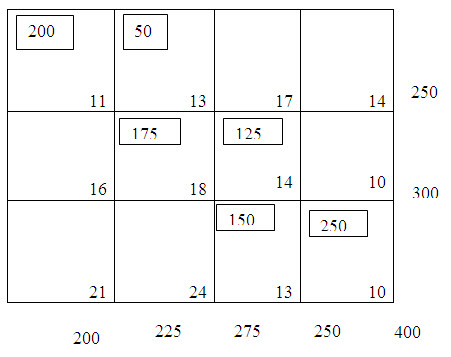
Table – 1
The transportation cost according to the above route is given by,
z = (200x11) + (50x13) + (175x18) + (125x14) + (150x13) + (20x10)
= Rs.12,200.
Least cost or Matrix Minima method
Step 1 : Determine the smallest cost in the cost matrix of the transportation table. Let it be Cij. Allocate xij = min (ai, bj) in the cell (i,j).
Step 2 : If, xj = ai, cross off the ith row of the transportation table and decrease bj by ai. Go to step3.
If xij = bj, cross off the jth column of the transportation table and decrease ai by bj. Go to step3.
If xj = ai = bj, cross off either the ith row or jth column but not both.
Step 3 : Repeat steps1 and 2 for the resulting reduced transportation table until all the rim requirements are satisfied. Whenever the minimum cost is not unique, make an arbitrary choice among the minima.
Problem: Obtain an initial basic feasible solution to the following distribution of products to various destinations from the sources as given in Problem No.1.
|
Sources, b |
Destinations, a |
Supply, Sbj |
|||
|
a1 |
a2 |
a3 |
a4 |
||
|
b1 |
11 |
13 |
17 |
14 |
250 |
|
b2 |
16 |
18 |
14 |
10 |
300 |
|
b3 |
21 |
24 |
13 |
10 |
400 |
|
Demand, Sai |
200 |
225 |
275 |
250 |
|
Solution : Since, Sai=Sbj=950, there exists a feasible solution to the transportation problem. The initial feasible solution can be obtained as given below following Least-Cost Method.
Following the least cost method, the first allocation is made in the cell (3,4), the magnitude being x34 = min. (400, 250)=250. This satisfies the requirement at a4 and thus we cross off the fourth column from the table. The second allocation is made in the cell (1, 1) of magnitude x11 = min. (250, 200) = 200 which satisfied the required at a1 and therefore, we cross off the first column from the table. This yields table 2.
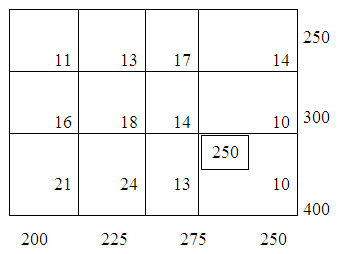
Table – 1
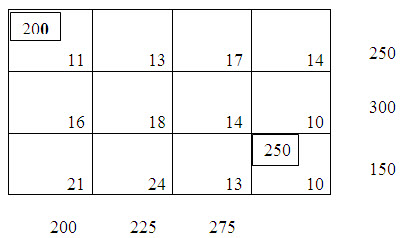
Table – 2
Now there is a tie for third allocation. We choose arbitrarily the cell (1, 2) and allocate x12= min. (50, 225) = 50. Cross off the first row. Fourth allocation is made in the cell (3, 3) with magnitude x33= min.(150, 275)=150. After crossing off the third row, it results in table 3.
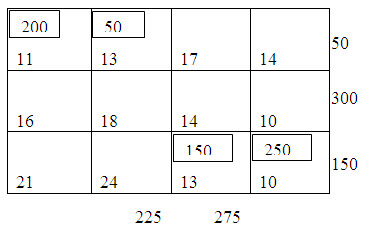
Table – 3
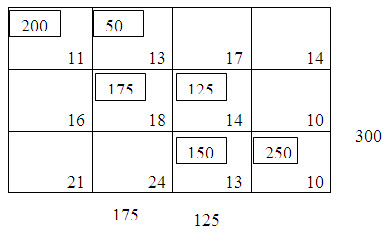
Table – 4
Fifth allocation is made to the cell (2, 3) of magnitude x23=min. (300, 125) = 125 and the sixth allocation is given by x22=min (175, 175) = 175.
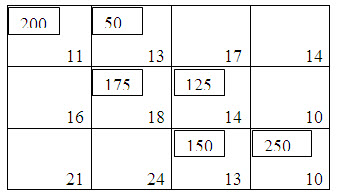
Table - 5
Thus we get the initial basic feasible solution as displayed in table 5. The transportation cost according to the above route is given by,
z = (200x11) + (50x13) + (175x18) + (125x14) + (150x13) + (250x10) = Rs.12,200.
The Row Minima Method
Step 1 : The smallest cost in the first row of the transportation table is determined. Let it be Cij. Allocate the maximum feasible xij=min (a1,bj) in the cell (1,j).
Step 2: If x1j=a1, cross off the 1st row of the transportation table and move down to the second row. If x1j=bj, cross off the jth column of the transportation table and reconsider the first row with the remaining availability.
If x1j=a1=bj, cross off the 1st column and make the second allocation x1k=0 in the cell (1,k) with C1k being the new minimum cost in the first row. Cross of the first row and move down to the second row.
Step 3: Repeat steps1 and 2 for the resulting reduced transportation table until all the rim requirements are satisfied.
Problem:
Determine an initial basic feasible solution to the following transportation problem following row minima method.
|
Sources |
Destimation |
Supply, Units |
||
|
A |
B |
C |
||
|
I |
50 |
30 |
220 |
1 |
|
II |
90 |
45 |
170 |
3 |
|
III |
250 |
200 |
50 |
4 |
|
Requirements |
4 |
2 |
2 |
|
Solution:

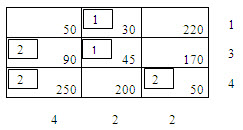
The Column Minima Method
Step 1: Determine the smallest cost in the first column of the transportation table. Let it be Ci1. Allocate the maximum feasible units to xi1=min(ai,b1) in the cell (i,1).
Step 2: If xi1=ai, cross off the ith row of the transportation table and reconsider the first column with the remaining availability.
If, xi1=b1, cross off the ith column and move towards right to the second column.
If, xi1=ai=b1, cross off the ith row and make the second allocation xk1=0 in the cell (k,1) with Ck1 being the new minimum cost in the first column. Cross of the first column and move down to the second column.
Step 3: Repeat steps1 and 2 for the resulting reduced transportation table until all the rim requirements are satisfied.
Problem:
Determine an initial basic feasible solution to the following transportation problem using column minima method.
|
Sources |
Destination |
Supply, Units |
||
|
A |
B |
C |
||
|
I |
16 |
19 |
12 |
14 |
|
II |
22 |
13 |
19 |
16 |
|
III |
14 |
28 |
8 |
12 |
|
Requirements |
10 |
15 |
17 |
|
Solution :
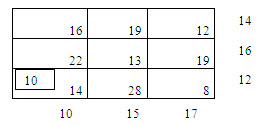
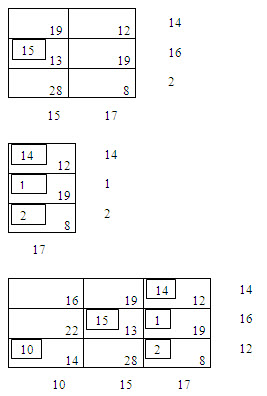
Vogels approximation method (VAM or penalty method):
Step 1: Calculate the penalties by taking differences between the minimum and next to minimum unit transportation costs in each row and each column.
Step 2: Circle the largest row difference or column difference. In the event of a tie, choose either.
Step 3: Allocate as much as possible in the lowest cost cell of the row(or column) having a circled row (or column) difference.
Step 4: In case the allocation is made fully to a row (or column) , ignore that row(or column) for further consideration, by crossing it.
Step 5: Revise the differences again and cross out the earlier figures. Go to step2.
Step 6: Continue the procedure until all rows and columns have been crossed out, i.e distribution is complete.
Problem
Obtain an initial basic feasible solution to the following transportation.
|
Sources, b |
Destinations, a |
Supply, Sbj |
|||
|
a1 |
a2 |
a3 |
a4 |
||
|
b1 |
11 |
13 |
17 |
14 |
250 |
|
b2 |
16 |
18 |
14 |
10 |
300 |
|
b3 |
21 |
24 |
13 |
10 |
400 |
|
Demand, Sai |
200 |
225 |
275 |
250 |
|
Solution: Since, Sai=Sbj=950, there exists a feasible solution to the transportation problem. The initial feasible solution can be obtained as given below.
Following the Vogels approximation method, the differences between the smallest and next to smallest costs in each row and each column are computed and displayed inside the parenthesis against the respective rows and columns. The largest of these differences is (5) and is associated with the first column of the transportation table.
Since the minimum cost in the first column is c11= 11, allocate x11=min. (250, 200)=200 in the cell (1,1). This exhausts the requirement of the first column and, therefore, cross off the first column. The row and column differences are now computed for the resulting reduced transportation table 1, the largest of these is (5) which is associated with the second column. Since c12 (=13) is the minimum cost, allocate x12 = min. (50, 225) = 50.
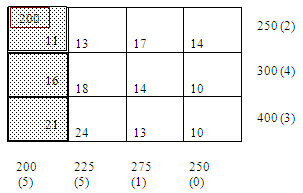
Table – 1

Table – 2
Thus exhausts the availability of first row and, therefore, we cross off the first row. Continuing in this manner, the subsequent reduced transportation tables and the differences for the surviving rows and columns are shown in table:

Eventually, the basic feasible solution obtained is shown in the following table:
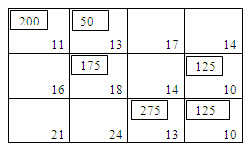
The transportation cost according to this route is given by
z = (200x11) + (50x13) + (175x18) + (125x10) + (275x13) + (125x10) = Rs.12,075